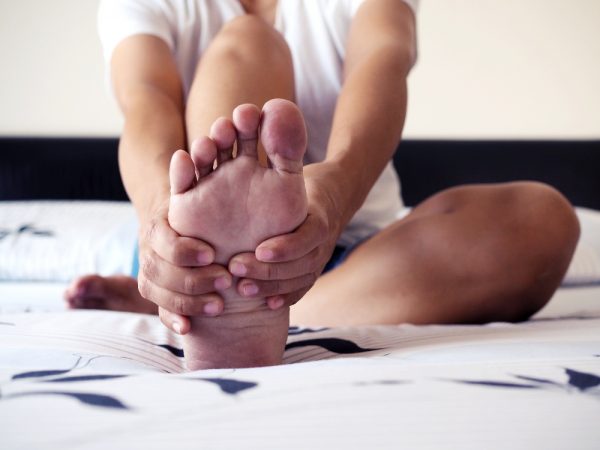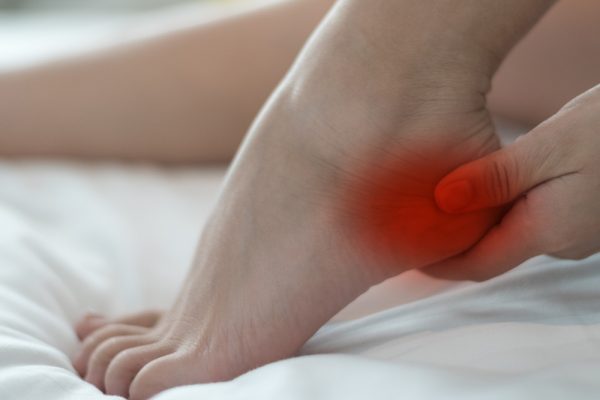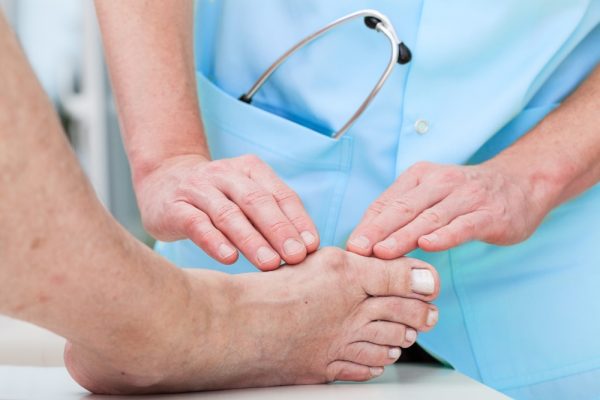Your feet are likely a part of your body you rarely think about. That’s normal. However, when you have a problem with your feet, you will suddenly become hyper-aware of them. Even the most minor issue with your feet can cause all sorts of problems with mobility and negatively impact your ability to do your job or even just live your life. The following are some of the most common foot problems you might experience and some advice on how to treat them:

1.) Corns & Calluses
Corns and calluses are painful, hard areas that develop on your feet. In general, they appear when your feet are trying to protect themselves from rubbing, pressure or injury. Although they are not dangerous, they can be irritating and pretty painful.
Quick Facts About Corns & Calluses
- Calluses are most often larger than corns and vary in shape. Corns tend to be well-defined, round and small.
- Corns are painful when pressed, while calluses aren’t that painful.
- Corns usually are surrounded by inflamed skin and have a hard, often distinct center.
- Calluses most often appear on the soles of the feet, under the balls or heels, the knees or palms of the hands. Corns show up in non-weight-bearing areas of the body.
How to Treat Corns & Calluses
- Moisturize: Use a moisturizer daily on the feet. Be sure any product you use contains ammonium lactate, urea and salicylic acid. This will soften the skin.
- Removal: Remove dead skin from calluses with a pumice stone. Soak feet in warm water before removing calluses.
- Shoes That Fit Properly: Ensure your shoes fit properly. Often corns and calluses are a result of ill-fitting shoes. In the case of corns, you might need to purchase silicone wedges or pads to counteract a foot deformity.
- See a Doctor: If you have fragile skin, diabetes, or have poor circulation seek medical attention.
2.) Plantar Fasciitis
This is a common problem associated with the thick band of tissue that runs across the bottom of the foot called the plantar fascia. It connects the toes to your heel bone. This area of the foot works to absorb the shock as you walk. Plantar fasciitis occurs when this band of tissue becomes inflamed and can be the result of stretching and tearing. Plantar fasciitis is actually one of the most common sources of heel pain. It can cause stabbing like pain, often occurring first thing in the morning. If you have this condition, you likely note a reduction in the pain as you go throughout your day.

Quick Facts About Plantar Fasciitis
- Often noticed first thing in the morning.
- Causes stabling pain in the heel area of the foot.
- Can be triggered by long periods of sitting.
- Pain can become worse after exercise, but doesn’t usually increase during exercise.
- Working abnormally or having a high arch or flat feet can increase the amount of stress placed on the plantar fascia, which can lead to plantar fasciitis.
- Teachers, factory workers and other occupations that requires hours of standing on hard surfaces can exasperate or cause plantar fasciitis.
- This condition is also common in runners.
How to Treat Plantar Fasciitis
- Physical Therapy: Specific types of physical therapy can stretch the area and strengthen the lower leg muscles.
- Night Splints: Your physical therapist might recommend you wear a night splint that stretches your arch and calf as you sleep.
- Orthotics: You can invest in arch supports either off-the-self or customized.
- Medication: You can also use pain relievers such as Advil or Motrin to reduce pain and inflammation.
- Other Treatments: In some cases, when less intensive treatments aren’t working, we recommend surgical procedures or injections.
3.) Bunions
This slowly developing condition is the result of the big toe joint leaning toward the second toe. When your toe stays in this improper alignment long enough, the structure of your bone itself changes. This leads to the development of what is referred to as a bunion bump. Bunions are a painful condition that is often referred to as hallux valgus. They are considered a foot deformity.

Quick Facts About Bunions
They can be influenced by strenuous activity like running.
- Ill fitting shoes, especially those that are too tight or narrow can cause bunions.
- Bunion bump usually looks red and swollen like a turnip. Interestingly enough, the word “bunion” comes from the Greek word turnip, hence the name.
- They usually start small and get worse overtime.
- There are many types of bunions, including adolescent, and those affecting the MTP joint and adult bunions.
- A bunioneette, which is also called a “tailor’s bunion” is found on the outside of the little toe. It is located in a different area of the foot, but is very similar to a bunion.
- If you have rheumatoid arthritis or other neuromuscular condition, you are at an increased risk of developing a bunion.
How to Treat Bunions
- Altered Footwear: In many cases, you can successfully treat your bunions by changing your footwear. You can modify shoes using a stretcher, taking pressure off specific areas of the foot. You should also make sure your feet are not compressed inside your shoes.
- Bunion Shield: You can use pads to cushion the painful area of the bunion. You can often purchase these over-the-counter.
- Orthotics: Custom made or over-the-counter shoe inserts can also be beneficial in treating bunions.
- Icing: Reduce the swelling of your bunion by applying ice for 20 minutes several times throughout the day. This helps to reduce swelling in the area.
Get in & Seen Quickly
If you are experiencing any of the above conditions or some others not mentioned in this piece, such as ingrown toenails, diabetic neuropathy, athlete’s foot, heel spurs or blisters, contact us today. We are able to treat you the same day in most cases, getting you in and out of the office quickly and back on your way. Contact us at The Foot & Ankle Group today at (293) 936-5400 and let us help you with your common foot problem.
Categorized in: Blog